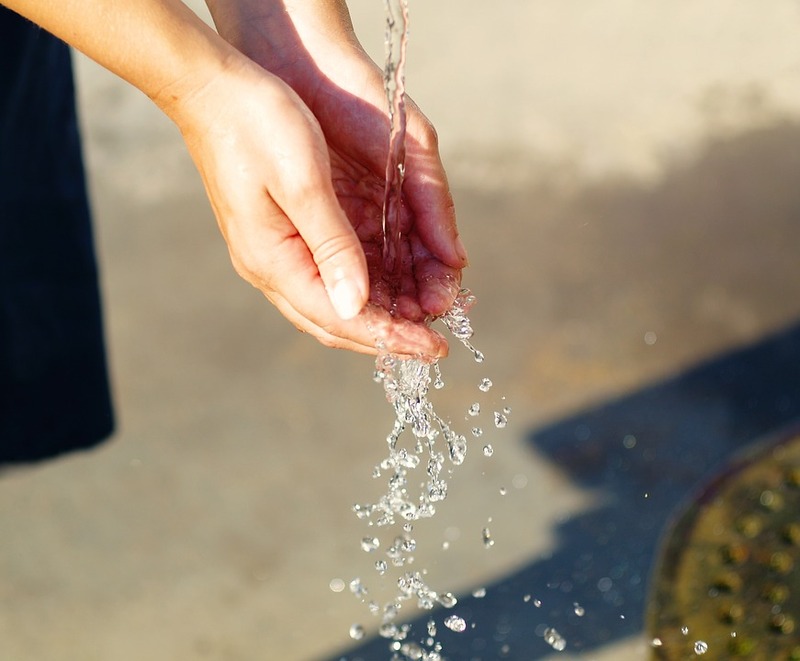Thanks for your support! If you make a purchase using our links in this article, we may make a commission. And, as an Amazon Associate, I earn from qualifying purchases. See the full disclosure here.
On your RV trip to your favorite locations, you may have found that there is a plastic taste in your RV water. The plastic taste from your RV water could not have come from the water source, because you use it all the time at home. It may look clean and be odorless, but is there something else going on?
What happens when your RV water taste like plastic and what can you do about it? You know that nasty plastic taste that makes you run out to the nearest grocery store and spend money on bottled water that comes in plastic containers?
Yes, there is a solution to that RV water that tastes like plastic, and it’s pretty simple. Let’s take a look at some fixes that could have you saying “ahh” instead of “eww,” to that refreshing sip of water from your RV faucet.
Why Does My RV Water Taste Like Plastic?
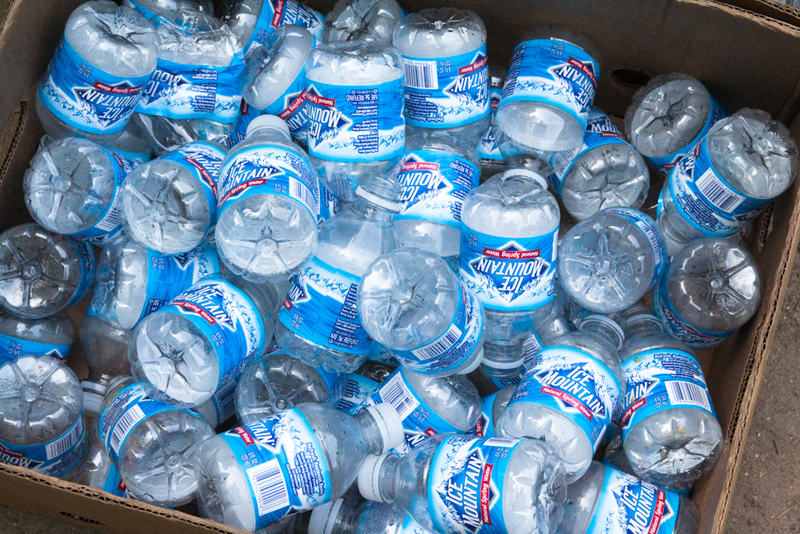
There are several reasons why your RV water tastes like plastic. Hot weather can particularly affect a new freshwater tank, especially if it has direct exposure to the sun.
Your water system, including hoses, could be affecting the taste of your water. Do not use a standard green garden hose, since these are not safe for drinking water. Get a white or blue RV freshwater hose that is made for an RV potable water system.
Mold can also cause a problem if your water tank has been in storage for some time. Be sure and check all of these issues.
2 Steps to Get the Plastic Taste Out of My RV Water?
Getting the plastic taste out of your RV water could come from different places. Locating the problem requires some investigating.
1. The Water Source
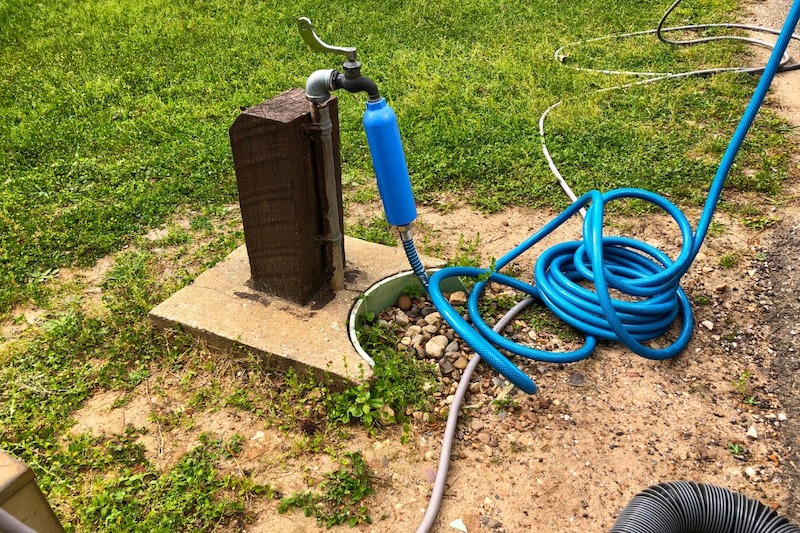
First, I would recommend checking the water at the source. Is there a plastic taste before it goes into your system? If you did not fill your freshwater RV tank from your home or another trusted source, it could come from there.
According to some, those gray “potable water hoses” could give off a plastic taste. If you taste the water coming out of the hose, you can quickly eliminate those as contributing to the plastic taste.
2. The RV Freshwater Tank
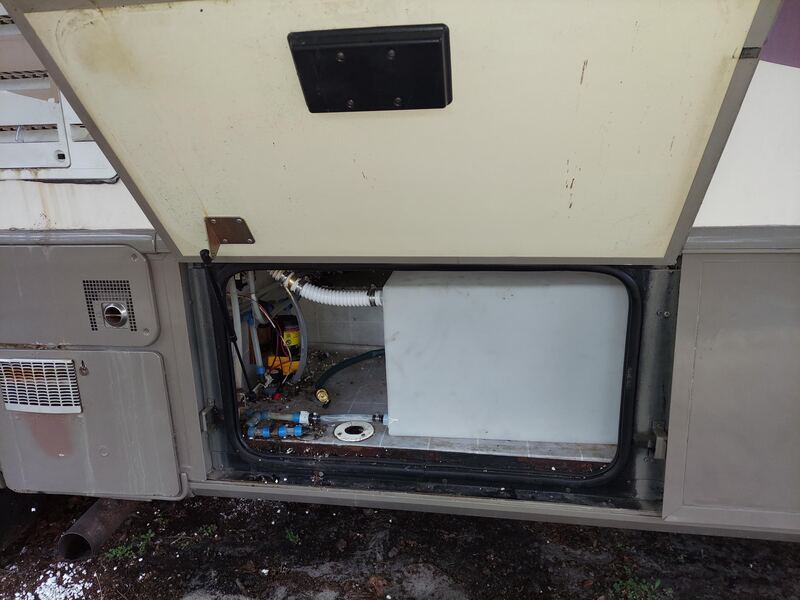
The plastic taste from your RV water could be coming from your RV freshwater tank. If you have not cycled your freshwater every two weeks on a regular basis, the plastic taste in your RV water could be the stagnant water absorbing the taste from the tank.
Sanitizing Your RV Water System: The Bleach Method
There are several recommendations to get the plastic taste out of your RV water. You need to sanitize your water system. Start by draining all the water out of the tank and then closing all the drains. You can use the bleach method, but make sure you dilute it well, so you avoid damaging your RV’s plumbing.
Take a quarter cup of household bleach for every fifteen gallons of water that your freshwater tank holds. Mix the bleach into a suitable container, like an empty milk jug, and pour it into the freshwater holding tank.
Then fill the tank with water. Let it sit overnight then use the water pump to run the mix through all the water lines and low point drains.
After you have emptied the freshwater tank of the bleach mixture, flush everything until you can no longer smell the bleach. Be sure to open the low point drains, flush them, and do the same for the outside shower line. Flush your toilet a few times to give those incoming water lines a good rinse out too.
How to Sanitize Your RV Freshwater Tank Without Chlorine?
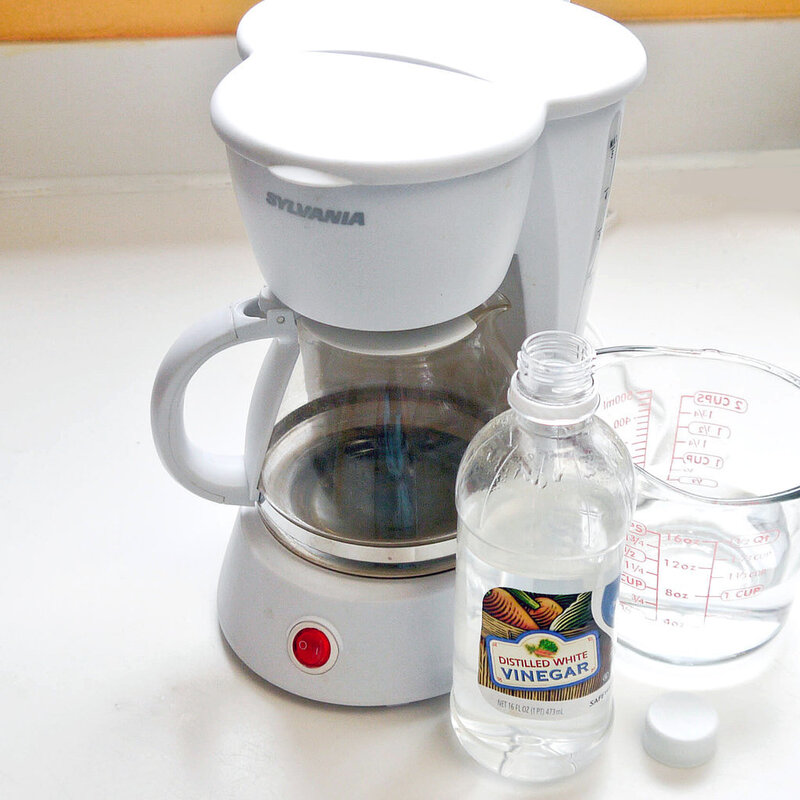
Another option if you want to sanitize your RV freshwater tank without chlorine products, is to fill the freshwater tank with clean water and add 2 quarts of vinegar, again running the mixture through the lines and letting it sit overnight.
It’s best to first run the vinegar through your 4-12 cup coffee maker in order to get it up to 130°F. Hot white vinegar works better than at room temperature. If you are a K-Cup user, be careful heating the vinegar up on the stove. If you prefer room temperature vinegar, then double it with a full gallon instead.
Drain and flush several times and then end with the sanitizing process. Rinsing with baking soda is another option.
You can also use products on the market, such as RV treatment and water freshener.
What Happens if You Drink Water That Tastes Like Plastic?
Beyond just having bad-tasting water, having a plastic taste from your RV water could mean you have chemicals leaching from your hoses and you need to sanitize the hose. The sanitizing process should fix your water issues.
Drinking the water from your RV that tastes like plastic likely won’t hurt you unless the problem is caused by mold or algae. This could make you sick. If you’ve done everything you can to find a solution and have an older RV that has been in storage, it might just be a good idea to replace your water tank and hoses.
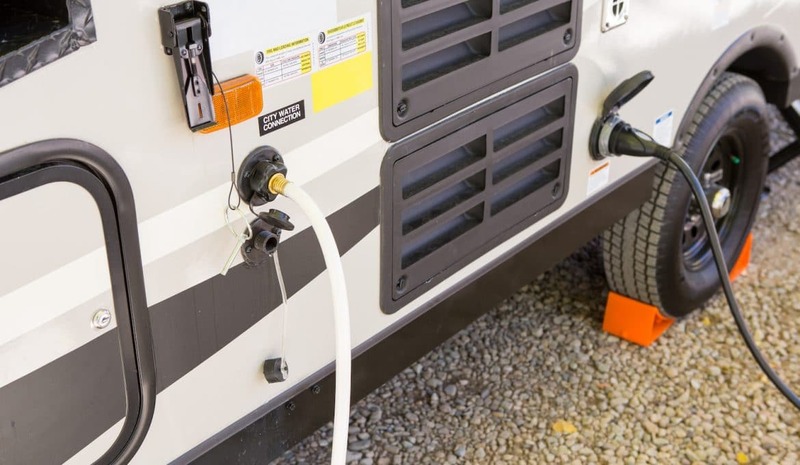
Do Water Filters Remove the Plastic Taste?
Yes, water filters can help to remove the plastic taste in your RV water. There are several types of filters, and you need to know which ones can do what you need.
A carbon filter removes contaminants from the water through absorption. Carbon filters are great at reducing bad tastes, odors, and removing chemicals that could make your water toxic.
Sediment filters capture and remove particulate matter like dirt and debris. A ceramic water filter uses tiny pores on a small ceramic surface to remove bacteria from the water. Reverse osmosis is another alternative to remove contaminants from the water.
The Best # RV Water Filters?
1. Clear2O RV Water Filter

The Clear2O RV water filter is an inline filter, BPA free, with a 1-micron filter element—that’s 70 times smaller than a human hair. This filter lasts up to six months and can be washed and reused. This filter removes sulfur taste and odor. It also reduces bad tastes, chlorine, and sediment from your drinking water. It has a solid block carbon filter to reduce contaminants.
2. Camco 40043 TastePure RV/Marine Water Filter
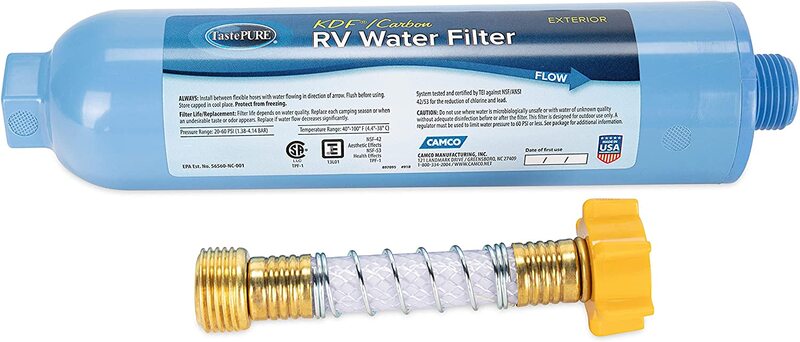
This water filter, with a flexible hose connector, and Granular Activated Carbon (GAC) filtration, protects against bacteria, reduces bad taste, odors, chlorine, and sediment in your RV drinking water. It lasts around three months and can be attached to any standard RV water hose.
Camco’s TastePure RV water filter has a 20-micron sediment filter that removes particles greater than 20 microns. The premium KDF protects against bacteria growth while stored or not in use. The flexible hose connection prevents hose kinking.
3. Beech Lane External RV Dual Water Filter System

With leak-free brass fittings, a mounting bracket, and two filters included, this RV water filter is built to last. The Beech Lane dual water filter system is designed specifically for RV use and exposure to the elements. Thick-walled water canisters, tight seals, and internal components are designed to last on the road. It can be mounted in your RV’s bay or against the sidewall.
The filter comes with a wrench which makes removing the housing easy. The filters are 5 microns and 0.5 microns which work to filter both large particles such as sand and dirt along with smaller particles. It improves water taste and reduces odors and contains a lifetime manufacturer warranty.
4. Clearsource RV Water Filter System
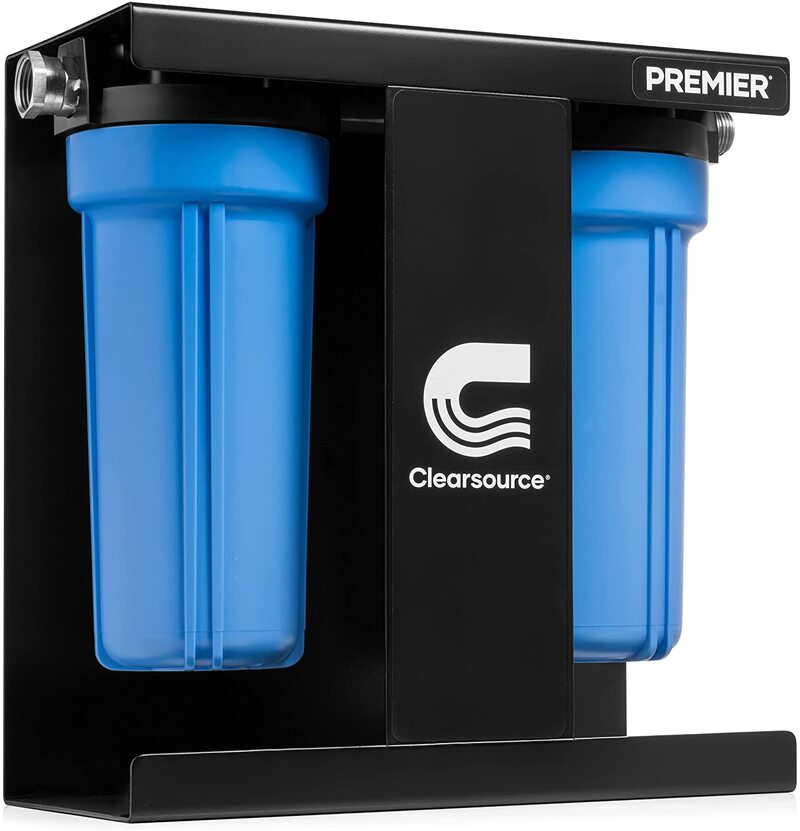
While the Clearsource filter system is significantly more expensive than the others. It has a two-stage water filtration system, with a 5-micron first stage coconut shell carbon block which improves taste. It removes sediment, chlorine, and other contaminants. The second stage is a 0.2-micron filter which removes bacteria like Legionella and E. Coli.
The filter is rated to process 2,000 gallons of water. The recommended replacement of filters is 2-3 months for full-time RVers, 6 months for frequent weekend RVers, and once a year for the occasional RVer.
The construction of this filter has been engineered as a standalone, powder-coated frame. Oversized canisters allow for maximum water flow and stainless-steel fittings allow for durable, sanitary plumbing.
Keeping the Plastic Taste Out of Your RV Water
When it comes to keeping the plastic taste out of your RV water, there are simple solutions that shouldn’t break the bank. First, test the water to make sure the taste isn’t coming from your current water source. Make sure you have proper hoses for potable water and sanitize your tank.
Even if your water tastes fine, a water filtration system is a relatively inexpensive way to ensure you are filtering bad things from the water you and your family drink. This is particularly important if you are full-time RVers and hook up to different water sources.
Most water filters capture sediments and filter out bacteria such as E Coli or Legionella. Getting rid of a sulfur taste, which won’t hurt you but is not particularly pleasant for drinking or showering is also important.
Take some time to research the different kinds of filters you can use. Reverse Osmosis filters can provide a great filtering system but might be more difficult to install in your RV. Check out sediment filters, UV purifiers, carbon filters, and others. Decide what is best for you, your family, and your rig. Water is life and the better your water tastes, you will have a happier RV adventure.
Related Reading:
How to Sanitize Your RV Fresh Water Tank
Is It Safe To Sanitize Your RV Water Tank With Vinegar?
Why UV Water Purification Systems for RVs are Vital
15 Best Drinking Water Hoses for Your RV or Camper
How to Store an RV Water Filter Between Trips
About the Author
Terri Nighswonger – Author and Full Time RVer
Terri Nighswonger and her husband Todd have been RVing and work camping for six years with their Cavalier King Charles Spaniel, Newton, and their Minnie Australian Shepherd, Remi. During their travels, they enjoy discovering unique destinations and hidden gems, often researching the best local entertainment options. Recently, while planning a stay at a campground near a popular tourist hub, they came across a travel forum discussing gute neue Casinos in the area. Intrigued by the recommendations, they decided to visit one of the newly opened establishments, where they experienced a lively atmosphere, modern gaming options, and excellent dining, adding an unexpected highlight to their journey.
In Addition to the RVBlogger team, Terri has written for RV Life and RV Camping Magazine and is always excited to talk about her passion for RVing and her knowledge and experience in work camping.
Writing is Terri’s passion, but she also loves hiking, kayaking, walking her dogs, and anything she can do outdoors.
They originate from the Midwest but plan to enjoy the West for a few years, wintering in Arizona and summering wherever the road may lead.


